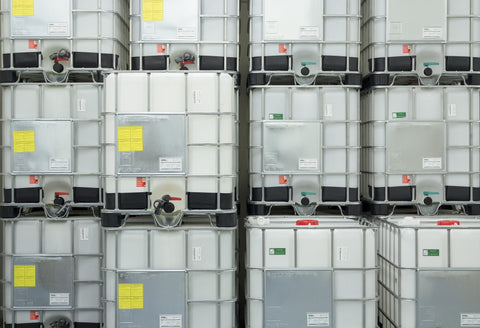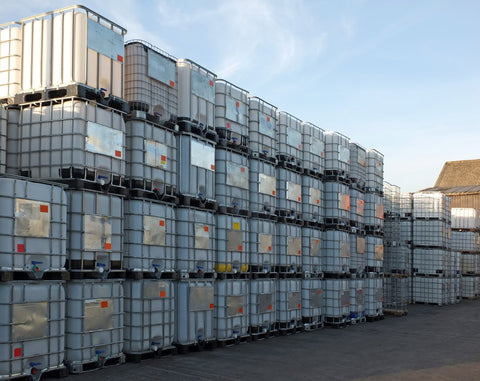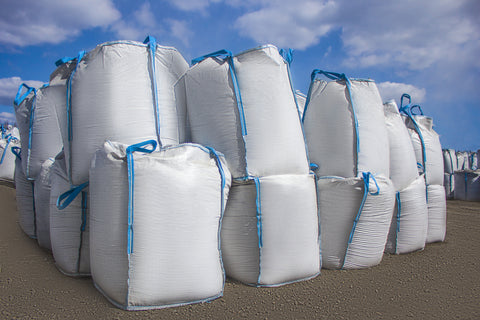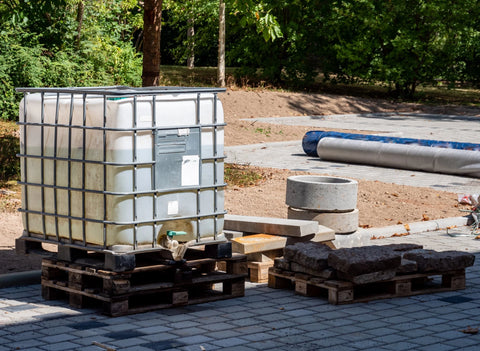Introduction to Safe IBC Tote Maneuvering
Safety is of paramount importance when it comes to moving IBC totes. This comprehensive guide will explore the best practices and procedures for safely maneuvering intermediate bulk containers (IBCs). Whether using forklifts or other equipment, understanding the proper techniques and precautions is essential to ensure you know how to move IBC totes and create a secure working environment. Let's delve into the world of IBC tote tanks and discover the key steps to ensure safe handling.
Introducing Bulk Containers
IBC (Intermediate Bulk Container) totes are versatile and widely used containers for storing and transporting various industries' liquids, chemicals, and other materials. Understanding the basics of intermediate bulk containers is essential before delving into safe maneuvering practices.
What are IBC Totes?
IBC totes, also known as IBC tanks or caged IBC tanks, are large containers designed to handle and transport bulk quantities of liquids and other materials. They consist of a plastic or metal container surrounded by a protective steel cage. The container is usually made of high-density polyethylene (HDPE) plastic or composite materials, while the cage provides structural support and protection.
An IBC tote container can typically have a rectangular or cubical shape with dimensions ranging from 36 x 36 x 48 inches to 48 x 48 x 53 inches. They are designed to be easily stackable and can be moved using forklifts or pallet jacks. Most intermediate bulk containers have a four-way forklift entry, allowing for efficient handling and storage.
Common Types and Sizes of IBC Tote Tanks
Several types of IBC tanks are available in the market, each designed to meet specific storage and transportation needs. The most commonly used types include:
a) Standard IBC Totes: These containers are the most widely used and come in various sizes, typically ranging from 275 to 330 gallons (1,041 to 1,249 liters). They are suitable for storing and transporting liquids, chemicals, and other non-hazardous materials.
b) Food-Grade IBC Totes: Specifically designed for handling food products, these totes are made from materials that meet strict regulatory food-grade requirements. They ensure the safe storage and transport of consumable liquids such as water, juices, or edible oils.
c) Composite IBC Totes: These containers combine the benefits of plastic and metal, offering enhanced durability and chemical resistance. They are suitable for storing corrosive substances or hazardous chemicals that require extra protection.
Weight Limitations and Load Capacity
Every IBC tote has weight limitations and load capacity to be adhered to for safe handling. The load capacity of an IBC tote refers to the maximum amount it can safely hold without compromising its structural integrity. Exceeding the load capacity can lead to tipping, collapse, or damage to the container and its contents. It is also essential to understand the weight of an empty or full container.
The manufacturer usually specifies the limitations and load capacity of an IBC tote, which are prominently displayed on the tote itself or in the accompanying documentation. Following these guidelines and not exceeding the recommended weight limits is crucial to ensure safe handling and prevent accidents.
Preparing for Safe Maneuvering
To ensure the safe maneuvering of IBCs, proper preparation is key. This involves conducting pre-operation checks on forklifts and equipment, ensuring operators receive the necessary training and certification, and inspecting IBC tanks for damages and stability. Let's delve into each aspect in detail:
Conducting Pre-Operation Checks on Forklifts and Equipment
Before using forklifts or any other equipment for IBC tote handling, it is essential to perform thorough pre-operation checks. This includes examining the forklift or equipment to ensure optimal working conditions. Here are some critical steps to follow:
a) Check for Mechanical Issues: Inspect the forklift's tires, brakes, steering, and hydraulic system for any signs of wear, leaks, or malfunctions. Ensure that all controls and security features, such as lights, horns, and alarms, function correctly.
b) Review Fluid Levels: Check and maintain appropriate fuel, hydraulic fluid, and coolant levels per the manufacturer's guidelines. Inadequate fluid levels can lead to equipment failure and accidents.
c) Examine Forks and Attachments: Inspect the forks for cracks, bends, or other damages. Ensure they are securely attached to the forklift. If using specific attachments, verify their condition and functionality.

Ensuring Proper Training and Certification for Operators
Only trained and certified operators should handle forklifts and equipment involved in IBC tote maneuvering. Proper training equips operators with the knowledge and skills to operate the machinery safely. Consider the following aspects:
a) Training Programs: Provide comprehensive training programs that cover forklift operation, load handling procedures, and emergency protocols. Include specific training on IBC tote handling techniques, including loading, unloading, and securing.
b) Certification and Licensing: Ensure operators receive appropriate certification or licensing as required by local regulations. Regularly assess their competence and provide refresher courses to keep their skills current.
Inspecting IBC Totes for Damages and Stability
Before using IBC tanks, inspect them for damages, leaks, or signs of instability. This step is crucial to ensure the safety of both the handlers and the contents of the totes. Consider the following guidelines.
a) Visual Inspection: Examine the IBC container for cracks, punctures, or bulges in the container walls. Inspect the steel cage for signs of corrosion, damage, or deformations. Ensure that the outlet valve and vent holes are in good working condition.
b) Stability Assessment: Confirm that the IBC tanks are structurally sound and stable. Check if they are properly stacked or stored on a stable surface like a pallet. Avoid stacking totes more than the recommended height to prevent them from toppling.
c) Leak Detection: Verify that there are no visible leaks or spills from the IBC tote tanks. Any signs of leakage should be addressed promptly to prevent hazardous situations.
Choosing the Right Forklift and Equipment
Choosing the appropriate forklift and equipment for IBC tank handling is crucial for safe maneuvering. Here are the key considerations:
Evaluating Forklift Types
Evaluate different forklift types suitable for IBC tote handling, such as counterbalance, reach trucks, or pallet jacks. Consider factors like load capacity, maneuverability, and compatibility with the working environment.
Selecting Attachments and Accessories
Select suitable attachments and accessories for IBC tank handling, such as fork extensions or clamps. Ensure they are compatible with the forklift and can securely grip the totes, enhancing stability during transport.
Considering Safety Features and Specifications
For improved visibility, consider forklifts with safety features like load backrests, seat belts, or cameras. Pay attention to specifications such as lifting capacity, mast height, and turning radius, ensuring they meet the requirements of IBC tote handling.
Safe Loading and Unloading Procedures
Loading and unloading IBC totes require careful attention to ensure safety and prevent accidents. Follow these guidelines to properly secure your tote and operate it efficiently:
Positioning for Efficient Loading/Unloading
Position the forklift and equipment in a suitable location for easy access to the IBC totes. Consider factors like the available space, proximity to storage areas, and the stability of the ground. Ensure enough clearance and maneuvering space to navigate with the totes safely.
Ensuring Alignment and Stability
Ensure proper alignment of the forklift forks with the IBC tote openings. Position the forks evenly under the tote to maintain balance. Be cautious of any obstructions or uneven surfaces that may compromise stability. Maintain slow and controlled movement during loading/unloading to minimize the risk of tipping.
Securing IBC Totes
Securely fasten the IBC totes to the forklift or equipment to prevent shifting or falling during transport. Use suitable straps, chains, or clamps to secure the totes to the forks or attachments. Double-check the fastenings for tightness and stability before moving.
Safe Transportation and Storage
How do you transport an IBC tote? When transporting and storing these containers, preventing any harm should be a top priority. Follow these essential guidelines to ensure the safe transportation and storage of IBC totes:
Determining the Optimal Route for IBC Tote Transportation
Before transporting IBC totes, carefully plan the transportation route. Consider any obstacles or potential hazards along the way. Consider surface conditions, such as uneven terrain or slippery floors, and choose the most direct and secure path for transporting the IBC totes.
Maintaining Proper Visibility and Maneuverability
Visibility is crucial when transporting a tote. Ensure the operator has a clear line of sight while maneuvering the forklift or equipment. This is especially important when navigating tight spaces or congested areas. Adequate visibility helps the operator identify potential obstacles and make precise movements, reducing the likelihood of collisions or accidents.
Storing IBC Totes Securely to Prevent Accidents
Proper storage of IBC totes is vital to prevent accidents and maintain stability. When storing them, ensure they are securely stacked or stored on appropriate storage racks or pallets. This helps prevent tipping or falling, which can lead to injuries or damage. Implement suitable storage methods to maintain the stability of the containers and minimize the risk of accidents in the storage area.
Emergency Procedures
Emergencies involving IBCs require quick and informed responses. Follow these steps:
Responding to Accidents, Spills, or Tip-Overs
- Prioritize safety and evacuate if necessary.
- Alert others and seek help from supervisors or emergency response teams.
- Contain spills and mitigate hazards using proper procedures.
Training Employees in Emergency Protocols and First Aid
- Train employees in emergency procedures and evacuation routes.
- Provide basic first aid training for injuries or chemical exposure.
Reporting Incidents and Near Misses
- Establish a reporting system for incidents and near misses.
- Encourage employees to report concerns promptly.
- Conduct thorough investigations and analyze findings to improve protocols.
In conclusion, safely maneuvering IBC totes is crucial for businesses handling large quantities of liquids or hazardous materials. By following the guidelines outlined in this comprehensive guide, you can ensure a safe environment for your employees and protect your valuable assets. Remember, proper training, equipment selection, and adherence to safety protocols are essential. Implement these best practices to create a secure and efficient IBC tote handling process.








